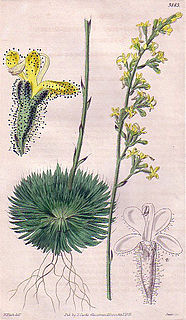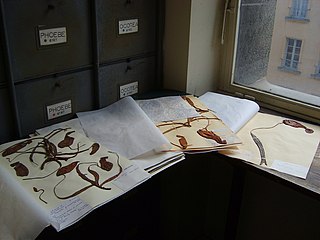
The H. H. Hunnewell estate in Wellesley, Massachusetts was the country home of H. H. Hunnewell (1810–1902), containing over 500 species of woody plants in 53 families. The estate remains in the family, and includes the first (1854) topiary garden in the United States, featuring intricate geometrically clipped native Eastern white pine and Eastern arborvitae. A collection of specialty greenhouses feature over 1,000 plant species. The estate has been cared for by six generations of the Hunnewell family.

The Bartlett Arboretum and Gardens in Stamford, Connecticut contains 93 acres of parkland, gardens, landscapes, and hiking trails that focus on the regional plants, ecology and character of Southwestern New England. The Arboretum is open and accessible to the public every day of the year and is located at 151 Brookdale Road.

Alfred Rehder was a German-American botanical taxonomist and dendrologist who worked at the Arnold Arboretum of Harvard University. He is generally regarded as the foremost dendrologist of his generation.
The Plant Collections Network (PCN) is a group of North American botanical gardens and arboreta that coordinates a continent-wide approach to plant germplasm preservation, and promotes excellence in plant collections management. The program is administered by the American Public Gardens Association from its headquarters in Kennett Square, Pennsylvania in collaboration with the USDA- Agricultural Research Service.

Elmer Drew Merrill was an American botanist and taxonomist. He spent more than twenty years in the Philippines where he became a recognized authority on the flora of the Asia-Pacific region. Through the course of his career he authored nearly 500 publications, described approximately 3,000 new plant species, and amassed over one million herbarium specimens. In addition to his scientific work he was an accomplished administrator, college dean, university professor and editor of scientific journals.
The elm cultivar Ulmus 'Atropurpurea' [:dark purple] was raised from seed at the Späth nursery in Berlin, Germany, circa 1881 as Ulmus montana atropurpurea, and marketed there till the 1930s. At Kew it was renamed U. glabraHuds. 'Atropurpurea', but Späth used U. montana both for wych elm and for U. × hollandica hybrids, so his name does not necessarily imply a wych elm cultivar. 'Atropurpurea' was later classed as a cultivar by Boom in Nederlandse Dendrologie 1: 157, 1959. Photographs of an U. glabra 'Atropurpurea' hedge at Wakehurst Place, England, though they show untypical 'coppice' leaves, appear to confirm that Späth's cultivar was synonymous with 'Purpurea', sometimes called U. × hollandica 'Purpurascens'.

The elm cultivar Ulmus 'Koopmannii' was cloned from a specimen raised from seed sent from Margilan, Turkestan by Koopmann to the Botanischer Garten Berlin c. 1880. Noted in 1881 as a 'new elm', it was later listed by the Späth nursery, catalogue no. 62, p. 6. 101, 1885, as Ulmus Koopmannii, and later by Krüssmann in 1962 as a cultivar of U. minor. Margilan is beyond the main range of Ulmus minor. Augustine Henry, who saw the specimens in Berlin and Kew, believed Koopmann's Elm to be a form of Ulmus pumila, a view not shared by Rehder of the Arbold Arboretum. Ascherson & Graebner said the tree produced 'very numerous root shoots', which suggests it may be a cultivar of U. minor. Until DNA analysis can confirm its origin, the cultivar is now treated as Ulmus 'Koopmannii'.
The Wych Elm cultivar Ulmus glabra 'Dovaei' was raised by the André Leroy nursery at Angers, France, as Ulmus dovaei before 1868.
The Wych Elm cultivar Ulmus glabra 'Maculata' was listed as Ulmus scabra maculata in the 1831-1832 catalogue from the Audibert brothers' nursery at Tonelle, near Tarascon in France.

The Siberian Elm cultivar Ulmus pumila 'Pendula' is from northern China, where it is known as Lung chao yü shu. It was classified by Frank Meyer in Fengtai in 1908, and introduced to the United States by him from the Peking Botanical Garden as Weeping Chinese Elm. The USDA plant inventory record (1916) noted that it was a "rare variety even in China". It was confirmed as an U. pumila cultivar by Krüssmann (1962).
The hybrid elm cultivar Ulmus × hollandica 'Cinerea' was first listed by George Lindley in 1815, as Ulmus cinerea, the Ash-coloured Elm, and later by the André Leroy Nurseries, Angers, France, in 1856. It was distributed as Ulmus cinerea by the Baudriller nursery, Angers, and as Ulmus montana cinerea by Louis van Houtte of Ghent. A specimen in cultivation at Kew in 1964 was found to be U. × hollandica, but the tree at Wakehurst Place remains listed as U. glabra 'Cinerea'.
The hybrid elm cultivar Ulmus × hollandica 'Dumont' was a very vigorous elm raised from a tree discovered by a gardener on the estate of M. Dumont at Tournay, Belgium, c. 1865.

The elm cultivar Ulmus × hollandica 'Haarlemensis', said to have been grown from seed c.1880 from a hybrid parent tree, was first listed by Springer as U. campestris haarlemensis in 1912.

Von Gimborn Arboretum is a large living collection of woody plants in the Netherlands.The arboretum is situated in Doorn, province of Utrecht, about 25 km to the east from the city of Utrecht, and together with its nursery currently occupies an area of 27 ha. It is named after its founder, German ink manufacturer Max Th. Von Gimborn (1872–1964), which started it in 1924 as a private collection of conifers and ericaceous plants. The collection was laid down as a 23 ha landscape garden designed by Gerard Bleeker. It is still one of the largest conifer collections in Western Europe, though now it contains many other trees and shrubs as well. It holds national plant collections of conifers, Ericaceae, Aceraceae, Betulaceae, Euonymus, Fraxinus, Laburnum, Magnolia and Syringa. A number of cultivars of woody plants originate there. The arboretum is open to the public daily for a small fee.

A botanical and horticultural library is a library specializing in the preservation and collection of literature and materials about plants. The mission of many botanical and horticultural libraries is to make accessible and available to those who use it the information on this topic.
Donald Wyman was an American horticulturist, the head of horticulture at Harvard University's Arnold Arboretum from 1935 to 1970.
Peter Shaw Green (1920–2009) was an English botanist.
The Field Elm cultivar Ulmus minor 'Viminalis Betulaefolia' (:'birch-leaved') is an elm of uncertain origin. An U. campestris var. betulaefolia was listed by Loddiges of Hackney, London, in the catalogue of 1836, and later by Loudon in Arboretum et Fruticetum Britannicum (1838). Henry described an U. campestris var. betulaefolia at Kew in 1913, obtained from Fulham nurseryman Osborne in 1879, as "scarcely different from var. viminalis". Melville considered the tree so named at Kew a form of his U. × viminalis, while Bean (1988), describing U. 'Betulaefolia', likewise placed it under U. 'Viminalis' as an apparently allied tree. Loudon and Browne had noted that some forms of 'Viminalis' can be mistaken for a variety of birch. An U. campestris betulaefolia was distributed by Hesse's Nurseries, Weener, Germany, in the 1930s.

The elm cultivar UlmusDensa was described from specimens growing near Ashkabad as U. densaLitv. in Schedae ad Herbarium Florae Rossicae (1908). Litvinov, reporting it growing wild in the mountains of Turkestan, Ferghana, and Aksu, as well as in cultivation, considered it a species, a view upheld by the Soviet publications Trees and Shrubs in the USSR (1951) and Flora of Armenia (1962), and by some current plant lists. Other authorities take it to be a form of U minor, distinctive only in its dense crown and upright branching.

















